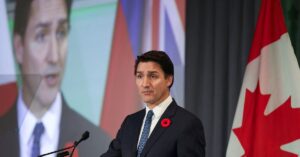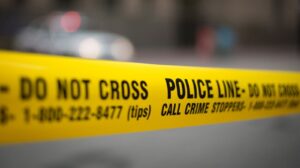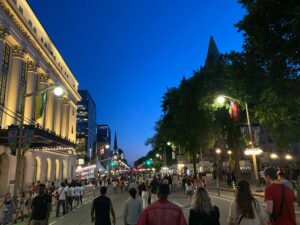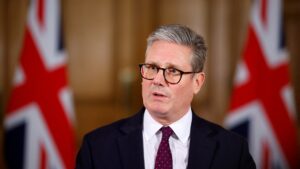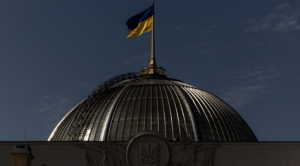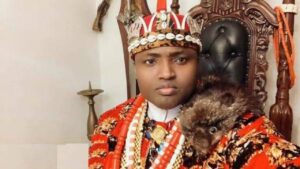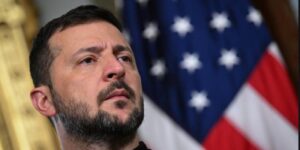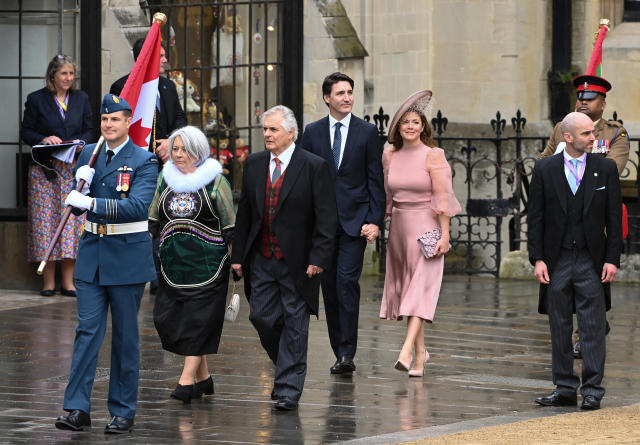
Prime Minister Justin Trudeau and Gov. Gen Mary Simon were among the dignitaries on hand as King Charles III was crowned at London’s Westminster Abbey on Saturday, marking the formal celebration of the start of his reign as King and his role as Canada’s head of state.
The coronation was a two-hour traditional Anglican ceremony that combined ancient traditions and pomp and pageantry with a few modern touches.
More than a dozen Canadians were among the ceremony’s guests of about 2,000. People in the crowd ranged from world leaders and aristocrats to community workers and first responders.
A drizzle fell as the Canadian delegation entered the church, led by flag-bearer and astronaut Jeremy Hansen.
Indigenous leaders were also on the Canadian guest list, including Assembly of First Nations National Chief RoseAnne Archibald, President of Inuit Tapiriit Kanatami Natan Obed and President of the Métis National Council Cassidy Caron.
Trumpets sounded as King Charles and Camilla, the Queen Consort, entered the church, where monarchs have been crowned since 1066. They were preceded by a procession of dignitaries who earned national honours from their countries, including historian Margaret MacMillan, who is a companion of the Order of Canada, and Cross of Valour recipient Leslie Arthur Palmer.
Charles is the 40th sovereign to be crowned in the abbey. At 74, he is also the oldest. He no longer has executive or political power, and the service was purely ceremonial. Charles automatically became King when his mother, Queen Elizabeth, died in September.
For the first time, female clergy took part in the ceremony. It was also the first to include representatives of the Buddhist, Hindu, Jewish, Muslim and Sikh faiths.
Thousands of people from around the world camped overnight along a two kilometre route travelled by the procession. Canadian flags were on display amid the sea of Union Jacks.
After the ceremony, large crowds cheered as five RCMP officers rode ahead of the gold state coach carrying King Charles and Queen Camilla, who was also crowned, as they returned from the abbey to Buckingham Palace in a military procession.
Back in Canada, some royal watchers set their alarm clocks to watch the proceedings in London, though polls have suggested many are lukewarm about the event — and the new monarch himself.
That sentiment was on display on the ground in London as well. The anti-monarchy group Republic said six of its members, including its chief executive, were arrested as they arrived at a protest.
Trudeau issued a statement shortly after the ceremony.
“Today, we ring in the reign of His Majesty King Charles III and reaffirm Canada’s enduring commitment to the Commonwealth,” he said. “As we celebrate this momentous occasion, let us be reminded of our shared values of inclusivity, diversity, and respect for human rights as we work together to build a better future for all members of the Commonwealth.”
Trudeau’s whirlwind trip to the United Kingdom, which ends Sunday, also included separate meetings Saturday with his British counterpart, Rishi Sunak, as well as New Zealand Prime Minister Chris Hipkins.
In an interview ahead of the coronation, Ralph Goodale, High Commissioner for Canada in the United Kingdom, stressed the strong ties between the two countries.
He cited the RCMP’s prominent position in the procession, and the fact that Charles met with Canadian Indigenous leaders right before the coronation.
“As the senior member in the Commonwealth that Canada is acknowledged to be, as a country that has a very close, long lasting relationship with the U.K. and the monarchy, Canada’s participation in these activities is very important,” said Goodale.
“If you look down the Mall, amidst all the Union Jacks, the first non-British flag you will see is the Canadian flag. Canada has that distinction within the Commonwealth and it’s one that’s important to us and important to the palace.”
Goodale said a Canadian tour for King Charles is “very much in the planning process.”
“The options are being very actively considered now as to what time of year. Then there will be the difficult questions of where they would go. It will be a tough choice of where the itinerary will be.”

